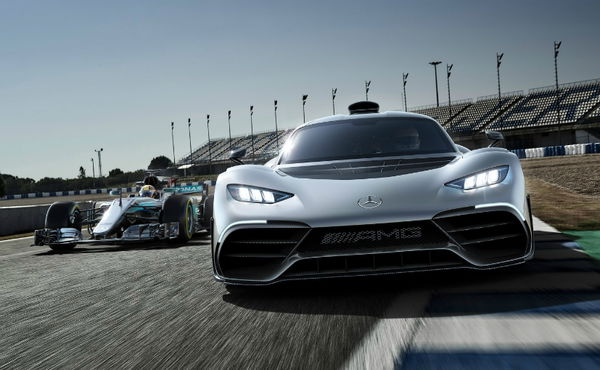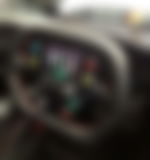

We now have the latest entrant to the list of Road Car inspired with Formula One Technology. The Mercedes Project One is here and it is breathtaking. When V6 hybrid engine technology was introduced, it was said that this move was to make F1 road relevant.
While on the racing front, the engine received a lot of flak, it was to be seen whether it’ll make it to the road or not and finally when Mercedes announced that they’ll use the current engine ditto into a race car, interest soared higher and higher.
ADVERTISEMENT
Article continues below this ad

And finally it’s here. The turbocharged V6 engine itself has an electric motor built into its turbocharger for eliminating turbo lag. Meanwhile another 160bhp e-motor works on the crankshaft. Then another two 50,000rpm, 160bhp electric motors independently drive each of the front wheels, allowing torque-vectoring, lightning-quick launches. Those front motors also allow a zero-emission EV mode, during which your £2.5m AMG hypercar becomes front-wheel drive (like the EV mode in a BMW i8).
As unique as the car is, you might be surprised to know that it’s not the first one to employ Formula One technology. Given Formula One’s open wheeled single seater nature, a technical nexus between a Formula One car and a road car does not appear outright. But unknown to all the former is a test bed for manufacturers to perfect tomorrow’s technology to trickle it down to their road cars.
Don’t believe me? Here’s a take at other such Road cars that employed technology used in a formula one car.
Red Bull – Aston Martin Valkyrie: When Formula One Technology met Style and Substance

Last year Red Bull Racing and Aston Martin pulled the wraps off the AM-RB-001, the birth child of the aerodynamic wizardry of Adrian Newey and technical prowess of the Aston Martin brand.
The result was a car fit for Mr. Bond’s official duties whenever the next movie comes out. This car is being considered as the next big leap in the hyper car genre. Comparisons to the legendary Gordon Murray designed McLaren F1 of 1994 is unavoidable.
The project was envisioned with two goals in mind. The first was to create a car that’ll achieve a 1:1 power to weight ratio. Second, to be at least as fast as an F1 car around a circuit. While the two goals can be termed as the project’s soul, the challenge lay in mating them to a road car.
So you want to beat an F1 car? What better way than to rope in the most successful designer in F1 history. A man who has delivered 10 championship-winning cars in his career. Someone who has taken the likes of Williams, McLaren and Red Bull to new heights.
As ambitious as the AM-RB 001 project is, the obstacles are no less daunting. To push a road car design to such limits required the imposition of aerodynamic characteristics of an F1 car to a road car, to an extent never seen before. All the Formula One technology is not easy to control while simultaneously keeping it under the norms of a road car.This is what the wizard has done by exploiting the sport’s technologies to trickle them down to his dream project. The car employs front and rear diffusers to generate massive levels of downforce and create a ground effect. While current gen ERS technology is also rumored to have made its way inside the hood. F1 grade suspension setup will also be introduced to cope up with so much force and power. The car is still miles away from production and there’s still a lot of honing to be done before it sees the light of the day.
Follow LCF1, a facebook page which brings you original and unique F1 memes.
McLaren F1

The legendary F1 holds a cult status in the road spec racing car fraternity. The car that broke the fastest production car record in its time. It quickly took to the top steps of the best car ever produced. This car raced its competition to dust and the wallets of those who were nevertheless passionate enough to buy this behemoth. And for those who could not even dream of buying it, the subtle monster forever adorned their poster walls.
It came from the same house that is only the second oldest in the elite sporting pedigree of Formula One. The car was the posthumous result of the vision of founder Bruce McLaren to bring racing technology to road cars. However, for long the group, having passed into private hands after Mr. Mclaren’s death in 1970, continued to focus solely on racing. That changed when Gordon Murray was able to convince Ron Dennis in 1988 to build an ultimate road car. A car that would be heavily influenced by the company’s Formula One experience and technology.
Finally, in 1992 the wraps came off and the McLaren F1 was presented to the world. True to its name, the car relied heavily on Formula One technology to achieve its objectives. To begin with, the car featured an unconventional 3 seater configuration. The driver was placed in the centre of the cabin to mimic Formula One’s central driving position style.
The McLaren F1 was the first production road car to use a complete carbon fibre reinforced polymer monocoque chassis structure. The same chassis structure as employed in Formula One cars of 1980s. Incidentally McLaren was also the first to introduce it to Formula One in 1981.
It was equipped with an underbody and rear diffusers akin to a formula one car. In other words, the F1 exploited ground effects to keep the car from taking a flight, literally!
BAC Mono

The BAC (Short for Briggs Automotive Co.) is small company run by two brothers Neill and Ian based in Liverpool, England. The brothers founded the company with an intention to cater to the needs of enthusiasts by producing specialized sports cars. Their efforts came to fruition in 2011 when they rolled out a 2.3 litre 4-cylinder Cosworth powered Mono, a single seater road-legal sports car.
Being a single seater, the Mono is more closer to F1 than an average sports car but the similarity runs deeper than you think.

The Mono uses a rollover structure that is compliant to the FIA regulations. The same regulations that an F1 car must meet before being deemed fit for racing. Its single seater nature means it lacks the traditional dashboard. All the essential information from speed to fuel is displayed on the steering wheel just like a – yes you guessed it right – F1 steering wheel. The Mono’s steering is just as crowded as that of an F1 car with buttons for every purpose a road car needs right from indicators to a neutral button and a large screen in the centre completes the wheel that serves up as a speedometer, tachometer and indicates battery, oil and temperature levels. Accompanying the wheel are F1 inspired and now industry standard paddle shifters.
Another canny characteristic that Mono shares with F1 is that the Mono is custom built around the purchaser’s body shape, just like an F1 car. So the seats, pedals and steering wheel position are made specific to the ergonomic requirement of the purchaser.
Ferrari 355 F1

The Ferrari 355 was launched in 1994 and came at a time when things were not going very good for the road car division of the Italian marquee. Things were so bad that production had dropped to 50% and the flagship F40 had lost the title of fastest production car. To get its mojo back, Ferrari broke all conventions, even the old philosophy that real Ferrari’s were only the ones with 12 cylinder engines.
The F355 was a modern classic and an absolute beauty. Ask your elder brother and I’m sure he’ll affirm that at one point of time the car graced his desktop PC wallpaper.
Being a Ferrari meant that a technical nexus between its F1 division was guaranteed and the car did benefit from it as it incorporated an F1 style flat bottom with airflow channels to offset any lift by generating enough downforce.
But that’s not only why the car has found its way onto this list. The 355 became so successful that it spawned many variants over the years and in 1998 the 355 F1 variant was launched which incorporated a “paddle-shift” transmission as seen on F1 Cars.
The technology was invented by Ferrari in 1989. John Barnard is credited with employing the idea of a semi-automatic gearbox in an F1 car but he went a step further and eliminated the traditional gear stick and instead employed two paddles on either side of the steering wheel for up-shifts and down-shifts. The tech was run for the first time in the Brazilian Grand prix and it won on its debut. The tech was immediately taken by all the teams up and down the grid and within two years became the standard feature of an F1 car.
It’s fascinating that within 10 years of its introduction in F1, Paddle shift found its way to road cars and the 355 F1 became famous for being the first road car to employ that tech and today all super cars are using paddle shifters.
McLaren P1

ADVERTISEMENT
Article continues below this ad
Dubbed as the spiritual successor of the legendary McLaren F1, The McLaren P1 is filled up to the brim with Formula One technology courtesy McLaren’s presence and its heritage as an elite team within the sport.
Built on a now sports car standard, carbon fibre monocoque chassis which was derived from formula one car, McLaren scrounged deeper within its F1 division to propel the car ahead of its rivals.
On the engine front, the car’s twin turbo V8 engine was mated with an electric motor to work in tandem akin to the current F1 cars and produce a staggering 908 bhp while also being able to work on a standalone basis.
ADVERTISEMENT
Article continues below this ad
The car also comes with a DRS whereby the active rear wing of the car becomes flat to reduce the drag and downforce produced allowing an increased straight line speed by the press of a button on the steering wheel exactly like a formula one car.
The P1 also came equipped with the KERS tech harvesting energy under braking to provide a boost to the driver with the tap of a button.
ADVERTISEMENT
ADVERTISEMENT
ADVERTISEMENT
ADVERTISEMENT

